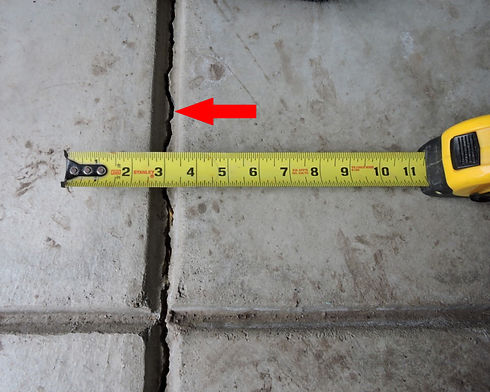
Garages
Common Garage Conditions
Visible damage in garages and interior drywall cracks are among the first signs of structural problems.

DRYWALL CRACKS GARAGE DOORS
Foundation movement can cause cracks around garage doors.

DRYWALL DISTRESS ON INTERIOR OF GARAGE
Foundation movement can manifest in all different types of drywall damage in the garage.

NAIL POPS
Nail pops are a type of drywall distress caused by foundation movement.

CRACKS IN FOUNDATION WALL
Cracks indicated that there is a structural problem with the foundation.

RACKED OR OUT-OF-SQUARE GARAGE DOORS
Damage to garage doors can be caused by upward concrete slab-on-grade or foundation movement.

SEPARATION AT CONCRETE FLOOR JOINTS
Severe separations between concrete floor sections can be due to construction defects, specifically the contractor’s faulty means and methods in the placement of the supporting soil.

FLOOR SLAB SETTLEMENT
Severe settlement of garage concrete floor sections can be due to construction defects, specifically the contractor’s faulty means and methods in the placement of the supporting soil.

CRACKS AND SEPARATION IN GARAGE FLOOR
Cracking within the joints of the garage concrete floor is entirely normal. However, excessive horizontal and vertical movement of the floor at the joints can lead to tripping hazards.

FLAT AREAS AND LOW SPOTS ON GARAGE FLOOR
The garage floor should be constructed at a slope to be able to drain water properly to the front of the garage. Sections of concrete floor can settle and become flat. Low spots on the surface can allow water to seep into the subgrade at floor joints and weaken the soil below the floor, worsening the damage over time.

CRACKS IN FLOOR SLABS
Minor stress cracks in a garage concrete slab-on-grade floor are common and do not necessarily mean that there is a problem. However, homeowners should monitor all cracks for additional movement.

SPALLING
Minor spalling of concrete does happen due to wear and tear. However, sections of severely spalled concrete in the garage can be due to construction defects, specifically the contractor’s deficient means and methods.

DISTRESS ON THE GARAGE EXTERIOR
Distress on the building envelope, such as siding near the garage exterior, is typically due to foundation movement.
Concrete Slab-on-Grade Garage Floors
The slab-on-grade basement floor is susceptible to movement and should be expected. The issue becomes the magnitude of movement. The amount of potential movement is estimated by geotechnical engineers and typically provided as information in the soils (geotechnical) report. Even with proper framing voids, basement finishes such as drywall, trim, millwork, flooring, and fixtures are susceptible to slab-on-grade movement.
Vertical slab movement of 1 to 3 inches is possible for slabs bearing on reconditioned soils with low to moderate swell potential. In some cases, vertical movement may exceed this range. Reconditioned soils are material that is removed and altered per engineering requirements to be more stable and placed back.
In a garage, some movement of a concrete slab-on-grade floor can typically be tolerated. Floor slabs should be separated from structural components to allow for the floor to move. It is essential for isolation joints and control joints to be placed in accordance with applicable Building Codes and standards published by the American Concrete Institute (ACI).
Damage to basement slab-on-grade floors can be associated with soil behavior, foundation movement, defective construction methods, or a combination of these factors.
